Putin The Sixty Billions treats the Russian workers "like pigs"
- Get link
- X
- Other Apps

Putin The Sixty Billions treats the Russian workers "like pigs"
___________________________________________________________
Gas workers in Russia’s Far East staged a mass rally to demand better working conditions and more transparency amid a reported coronavirus outbreak at their gas field, local media reported Tuesday.
Footage from the Gazprom energy giant’s Chayanda field, which supplies China with natural gas through the recently launched Power of Siberia pipeline, showed laborers crowded outside their barracks in violation of social distancing guidelines. Authorities quarantined Chayanda in mid-April after at least seven workers tested positive for Covid-19, a figure that surpassed 50 by Tuesday.
“They’re feeding us animal feed. We’re being held like pigs, are we pigs?” the workers can be heard saying in a profanity-laced address, according to a video published by the Yakutia.info news website.
“Where’s the quarantine? Where are the masks? There’s nothing! They drove us all into dorms, we’re carrying all kinds of infections,” the workers continue.
The Russian republic of Sakha’s crisis center took samples from all 10,500 Chayanda field workers and is awaiting coronavirus test results, according to Yakutia.info. “There are a lot of infected people, according to preliminary data,” the crisis center was quoted as saying.
In an open letter quoted by Yakutia.info, the workers complained of being kept in the dark about their results for almost a week (the tests were said to have been carried out last Wednesday, April 22) while living in cramped conditions.
“Avoiding physical contact is absolutely impossible in such living conditions. We eat from the same dishes, wash in communal baths and showers and change the same bed linens,” they wrote.
“Together with these circumstances, the simple lack of information about people’s fates, about the fate of infected people, can lead to irreparable consequences.”
Sakha governor Aysen Nikolayev later vowed to return the workers to their home regions, where healthy workers will be placed in observation and infected patients hospitalized, the crisis center said. Federal officials have ordered the Emergency Situations Ministry to start constructing a field hospital near Chayanda on Thursday, Nikolayev added.
Regional prosecutors said they’re inspecting compliance with health and labor codes at the gas field, the state-run TASS news agency reported.
The republic of Sakha has reported 166 coronavirus cases as of Tuesday. Russia’s nationwide total rose to 93,558 that day, placing it eighth among the countries most-affected by the pandemic.
Read the whole story
· ·
A leading scientist has said he would not put any money on an effective coronavirus vaccine being found any time soon.
But Prof Hugh Pennington said the virus could still be "seen off by Christmas" through social distancing, testing and contact tracing.
And he played down fears of the country being hit by a second wave of Covid-19 cases once the lockdown is lifted.
He also criticised the low number of tests that have been carried out.
Prof Pennington, a microbiologist who has previously advised both the UK and Scottish governments, was giving evidence to a meeting of the Scottish Parliament's health committee by video link.
He told the committee that, while there were about 80 groups across the world currently working on an effective vaccine, there was no guarantee that any would ultimately be successful.
And while he was "hopeful" that a vaccine would be found, he said he would "not be putting any money on it at this stage".
Prof Pennington added: "There is already evidence suggesting that immunity against Covid-19 is not particularly strong after infection.
"Many people don't really develop very much in the way of antibodies but they recover from the infection, which might suggest that traditional vaccines are not going to be particularly effective.
"I think probably the best thing we can hope for is a vaccine or a set of vaccines which will be partially protective, and they may not work as well in the elderly because most vaccines don't.
"So to put all our money on a vaccine as the way we can end the current crisis I think will be a mistake, because we may never get to that point."
He also said the UK did not currently have the capacity to manufacture a vaccine in sufficient quantities, and the country would therefore "just have to put our order in".
Despite this, he insisted that it could be possible to "see the virus off by Christmas" if the country "really blasts away" with its testing facilities.
And he claimed it was "very unlikely" there could be a second wave of the virus, as this was an idea linked to influenza epidemics - which he said are "quite different".
Prof Pennington said the ultimate goal should be to eradicate Covid-19, as had happened with diseases like Sars and smallpox.
He said: "It's a reasonably optimistic position, in that there's no reason in my view why we shouldn't look at Sars as the model - a virus we managed to control and eradicate, unlike flu, which is a virus we've never managed to eradicate and which kills people every year.
"I don't see any reason why we should be so pessimistic as to follow the flu model, when we know this virus is very different."
He said the current lockdown had been successful, but mass testing could and should have been rolled out "faster and more effectively" across the UK
"We don't have either a vaccine or antiviral drugs available for Covid-19, so prevention is the absolute paramount thing. The only way we know where the virus is is by testing. And we have a very good test.
"We could have done a lot more to get that test rolling in many, many centres. We had the test, but we didn't use all the facilities available - not just in public health or NHS laboratories, but in research institutes and universities."
And he said lessons must be learned for future virus outbreaks, as he warned: "There will be other pandemics."
He said: "We have to do better on our pandemic planning, we need to have better stocks of PPE and better testing facilities - not necessarily running, but to deal with surge capacity.
"We don't know when they will happen, we don't know how serious they will be, but if we don't spend the money to have the capacity to cope with them then we'll have the same issues we're having now with Covid-19."
Read the whole story
· · ·
DON'T bet on a coronavirus vaccine to end the pandemic, a leading scientist has told MSPs. Microbiologist Professor Hugh Pennington urged ...
Humanity will have to live with the threat of coronavirus “for the foreseeable future” and adapt accordingly because there is no guarantee that a vaccine can be successfully developed, one of the world’s leading experts on the disease has warned.
The stark message was delivered by David Nabarro, professor of global health at Imperial College, London, and an envoy for the World Health Organisation on Covid-19, as the number of UK hospital deaths from the virus passed 15,000.
A further 888 people were reported on Saturday to have lost their lives – a figure described by communities secretary Robert Jenrick as “extremely sobering” – while the total number who have been infected increased by 5,525 to 114,217.
The latest figures, which do not include deaths in care homes and in the community, put further pressure on the government amid continuing anger among NHS workers and unions over the lack personal protective equipment (PPE) for hospital and care home staff on the front line.
In late March the government’s health advisers said that if UK deaths from Coronavirus could be kept below 20,000 by the end of the pandemic, it would be a “good result” for country. But with an estimated 6,000 people having already died in care homes from Covid-19 – a figure not included in Saturday’s official tally – the 20,000 figure is likely already to have been exceeded.
In an interview with The Observer Nabarro said the public should not assume that a vaccine would definitely be developed soon – and would have to adapt to the ongoing threat.
“You don’t necessarily develop a vaccine that is safe and effective against every virus. Some viruses are very, very difficult when it comes to vaccine development - so for the foreseeable future, we are going to have to find ways to go about our lives with this virus as a constant threat.
“That means isolating those who show signs of the disease and also their contacts. Older people will have to be protected. In addition hospital capacity for dealing with cases will have to be ensured. That is going to be the new normal for us all.”
The comments came as the former UK health secretary Jeremy Hunt said the only way forward was for nations to support a new global health system that would mean far more international cooperation between governments on health issues. It would also require richer nations doing more to support the health systems of the world’s poorest countries.
“I think global health security is going to be on that small but critical list of topics like climate change that we can only solve in partnership with other countries,” Hunt told The Observer.
In a clear criticism of US President Donald Trump who announced last week he was putting on hold funding to the World Health Organisation (WHO) Hunt added: “Surely the lesson of coronavirus is cure not kill…It certainly does not mean cutting their funding (to the WHO).
“One of the big lessons from this will be that when it comes to health systems across the world, we are only as strong as the weakest link in the chain.
“Although China has rightly been criticised for covering up the virus in the early stages the situation would have been whole lot worse if this had started in Africa. International cooperation and supporting health care systems of the poorest countries has to be a top priority in terms of the lessons we need to learn.”
Nabarro’s message is the second grim warning to come from senior ranks of the WHO in the last three days. On Friday, Maria Van Kerkhove, head of WHO’s emerging diseases and zoonosis unit, warned that there was no evidence that antibody tests now being developed would show if a person has immunity or is no longer at risk of becoming reinfected by the Covid-19 virus.
On Saturday it emerged that doctors and nurses treating Covid-19 face shortages of protective full-length gowns for weeks to come, as anger mounts over failures to stockpile them. Gowns were not included in a stockpile list prepared for a potential flu pandemic.
After The Guardian revealed new guidance from Public Health England which instructs healthcare workers to re-use disposable equipment, the GMB, which represents NHS and ambulance staff, said support was “draining away” from Health Secretary, Matt Hancock.
Saffron Cordery, deputy chief executive of NHS Providers which represents many trusts, told the Observer: “We are in a situation where we think this [issue] will last a couple of weeks, which probably does just take us to May. There is a shortage of gowns which is affecting some trusts, but not all. Some have none, and are using the alternatives.”
The government will attempt to gain control of the mounting PPE concerns by appointing Paul Deighton, chief executive of the London Olympics organising committee, to lead efforts to produce equipment in Britain.
Ministers also announced another £1.6bn cash injection to local councils as they attempt to stem a spiralling crisis in social care that is pushing some care providers into the red. Some have been paying inflated prices for commercial protective equipment.
Read the whole story
· · ·
DON'T bet on a coronavirus vaccine to end the pandemic, a leading scientist has told MSPs.
Microbiologist Professor Hugh Pennington urged authorities to "test, test, test" and said the killer virus could be "seen off by Christmas" by a combination of checks, social distancing and contact tracing.
Giving evidence to the Scottish Parliament's Health Committee, the Aberdeen University expert – who has previously advised both the Scottish and UK governments – said that while he is "hopeful" of a treatment, he will "not be putting any money on it at this stage".
Stating that the UK does not have the capacity to produce large quantities of a vaccine, he went on: "Probably the best thing we can hope for is a vaccine or a set of vaccines which will be partially protective, and they may not work as well in the elderly because most vaccines don't.
"So to put all our money on a vaccine as the way we can end the current crisis I think will be a mistake because we may never get to that point."
But Pennington said there is "no reason" why coronavirus may not be tackled by Christmas if authorities are "really blasting away" on testing.
He said: "There is already evidence suggesting that immunity against Covid-19 is not particularly strong after infection.
"Many people don't really develop very much in the way of antibodies but they recover from the infection, which might suggest that traditional vaccines are not going to be particularly effective."
The scientist went on: "There's no reason in my view why we shouldn't look at Sars as the model, a virus we managed to control and eradicate, unlike flu, which is a virus we've never managed to eradicate and which kills people every year.
"I don't see any reason why we should be so pessimistic as to follow the flu model, when we know this virus is very different."
Pennington said a failure to employ more robust testing and tracing had been a "policy error", and, in a warning for the future, he said: "There will be other pandemics.
"We have to do better on our pandemic planning, we need to have better stocks of PPE and better testing facilities - not necessarily running, but to deal with surge capacity.
"We don't know when they will happen, we don't know how serious they will be, but if we don't spend the money to have the capacity to cope with them then we'll have the same issues we're having now with Covid-19."
Read the whole story
· ·
As scientists unpack the new coronavirus day by day, we have come to know that it may cause gastrointestinal symptoms and, in some cases, even ...
Next Page of Stories
Loading...
Page 2
As scientists unpack the new coronavirus day by day, we have come to know that it may cause gastrointestinal symptoms and, in some cases, even ...

The Perfect Bio-weapon for the Population Control: Coronavirus Could Cause Male Infertility
https://tweetsandnews.blogspot.com/2020/04/1116-am-4282020-perfect-bio-weapon-for.html
___________________________________________________________________
Read the whole story
· ·
Cookie Notice
We use cookies to personalise content and ads, to provide social media features and to analyse our traffic. We also share information about your use of our site with our social media, advertising and analytics partners in accordance with our Privacy Policy. You can manage your preferences in 'Manage Cookies'.
Thank you for visiting <a href="http://nature.com" rel="nofollow">nature.com</a>. You are using a browser version with limited support for CSS. To obtain the best experience, we recommend you use a more up to date browser (or turn off compatibility mode in Internet Explorer). In the meantime, to ensure continued support, we are displaying the site without styles and JavaScript.

Symptoms of the novel coronavirus explained
Here's a list of symptoms of the virus and precautions people can take in order to better protect themselves as the novel coronavirus continues to spread around the world.

106-year-old woman out of hospital after beating coronavirus
A 106-year-old woman - believed to be Britain's oldest Covid-19 survivor - has left hospital after shaking off coronavirus and suspected pneumonia.

Respiratory therapist: Pandemic 'overwhelming'
Chicago respiratory therapist Brady Scott says he feels overwhelmed by the coronavirus pandemic. Scott says so many people need breathing machines that simply haven't been manufactured yet.

Virus provokes spike in demand for food pantries
The coronavirus pandemic has provoked a spike in demand for food pantries in the U.S. Providers have seen people lining up hours before pantries open.

What Causes Infertility?
Infertility can be a challenging and isolating experience, but there are many reasons why you aren't falling pregnant and causes of infertility as Obstetrician, Gynecologist, Infertility and IVF Specialist Dr Joseph Sgroi explains.

The new coronavirus: key terms explained
Here are some of the key terms surrounding the new coronavirus explained, as new words and phrases enter the mainstream and become conflated.

How the novel coronavirus progresses from day to day
Chinese scientists have identified a pattern of day-to-day symptoms typical of patients with coronavirus in a new study.
Covid-19, the disease caused by the new coronavirus (SARS-CoV-2), is largely known to cause respiratory complications such as pneumonia, shortness of breath, extreme coughing and even fatal acute respiratory distress syndrome in patients.
As scientists unpack the new coronavirus day by day, we have come to know that it may cause gastrointestinal symptoms and, in some cases, even neurological problems. But what about its effect on the rest of the body – specifically in terms of fertility and the urinary tract?
New research published in Nature Reviews Urology suggests that there is evidence that Covid-19 has implications for the urogenital tract, something which should be considered when treating Covid-19.
According to the paper, most patients with severe Covid-19 present with pneumonia-related symptoms, but some patients could develop serious urinary tract complications, including acute kidney injury (AKI), which requires continuous renal therapy.
Male reproductive system also affected
Besides kidney health, the paper states that male reproductive systems are especially vulnerable to Covid-19 infection. This has to do with dramatic changes in the sex hormones that have been observed in some patients with Covid-19.
This may lead to impaired function of the testes (gonadal function impairment).
The mechanism of Covid-19 and the reproductive system
It is already known that some viruses such as HIV, hepatitis B and C, mumps, Epstein–Barr and papilloma can cause viral orchitis, a condition where one, or both, of the male testes are inflamed. This condition may even lead to male infertility and testicular tumours.
In the case of coronavirus, testes autopsies from six patients who died from SARS – the virus which caused the 2003 outbreak – showed viral orchitis.
The researchers concluded that the new coronavirus may have the same effect. In the paper, they also refer to a previous study outcome where patients with Covid-19 showed dramatically decreased levels of testosterone in comparison to their healthy counterparts. According to them, this could be a sign that reproductive health is impaired.
What Covid-19 patients (and their doctors) should know
The researchers emphasised that those who are predisposed to kidney conditions are more at risk for Covid-19-related complications, and when they do contract the disease, health professionals should monitor their kidney health. In the case of young men contracting Covid-19 who wish to have children in the future, it is suggested they have a fertility consultation later to ensure that there is no impaired gonadal function.
Image credit: Getty Images
Compiled by Marelize Wilke
Read the whole story
· · · · · ·

» mikenov on Twitter: Top E.R. Doctor Who Treated Virus Patients Dies by Suicide nytimes.com/2020/04/27/nyr…
27/04/20 23:19 from Michael Novakhov on Twitter from Michael_Novakhov (1 sites)
Top E.R. Doctor Who Treated Virus Patients Dies by Suicide nytimes.com/2020/04/27/nyr… Posted by mikenov on Tuesday, April 28th, 2020 2:19am mikenov on Twitter
_____________________________________________________________________
https://tweetsandnews.blogspot.com/2020/04/coronavirus-news-review.html
- Healthcare workers as superspreaders - Google Search https://www.google.com/search?q=Healthcare+workers+as+superspreaders&rlz=1C1CHBF_enUS733US733&oq=Healthcare+workers+as+superspreaders&aqs=chrome..69i57j33.17937j0j7&sourceid=chrome&ie=UTF-8 …
- Michael Novakhov RetweetedMany times we make comments that set off a small daily lynching. May the Lord help us to be righteous in our judgments and not to begin or follow gossip that provokes an undeserved condemnation. #HomilySantaMarta
- Top E.R. Doctor Who Treated Virus Patients Dies by Suicide https://www.nytimes.com/2020/04/27/nyregion/new-york-city-doctor-suicide-coronavirus.html?smid=tw-share …
- Michael Novakhov RetweetedThe United States of America’s military is on watch 24/7/365. We’re all in.
- https://p.dw.com/p/3bQzu?maca=en-Twitter-sharing … SIPRI: Germany significantly increases military spending
- Gordon Chang on reports Kim Jong Un was wounded during missile test: 'Something is wrong' https://fxn.ws/357IJMA #FoxNews
Gordon Chang on reports Kim Jong Un was wounded during missile test: 'Something is wrong'
Foreign affairs expert and Asia analyst Gordon Chang said on “America’s Newsroom” on Monday that “something is wrong” in North Korea, adding that there is reason to believe that South Korea’s claim...foxnews.com - Gregg Jarrett: New evidence on Michael Flynn — drop all charges and let him sue his persecutors https://fxn.ws/2VHsLpd #FoxNews
- 'A Complete Public Health Nightmare': 100+ Tyson Workers Near Pasco Test Positive For COVID-19 . News | OPB https://www.opb.org/news/article/tyson-meat-workers-pasco-beef-slaughterhouse-covid-19/ …
- CDC: Blacks comprise 30 percent of COVID-19 cases http://www.louisianaweekly.com/cdc-blacks-comprise-30-percent-of-covid-19-cases/ …
- CDC added 6 new coronavirus symptoms to its guidelines https://bgr.com/2020/04/27/coronavirus-symptoms-cdc-adds-6-new-covid-19-signs/?subId3=xid:fr1588030413364jfh …
- Coronavirus link being explored over several cases of severely ill children in U.K. https://www.marketwatch.com/story/coronavirus-link-being-explored-over-several-cases-of-severely-ill-children-in-uk-2020-04-27?reflink=mw_share_twitter …
- 5:39 PM 4/27/2020 - Is meat safe? #FDA, Are you in charge of the food safety matters? What is going on? Are you investigating this? What is your understanding of this dangerous situation? https://tweetsandnews.blogspot.com/2020/04/539-pm-4272020-is-meat-safe-fda-are-you.html?spref=tw …
- #Tweets And #News - From #MichaelNovakhov: 5:39 PM 4/27/2020 - Is #meat safe? #FDA, Are you in... https://tweetsandnews.blogspot.com/2020/04/539-pm-4272020-is-meat-safe-fda-are-you.html?spref=tw …
- #FDA,
Are you in charge of the food safety matters? What is going on? Are you investigating this?
What is your understanding of this dangerous situation? #CIA #FBI #ODNI #Trump #CDC #Covid19 #Coronavirus #Meatplants #Covid19InMeatPlantWorkers #CoronavirusInPetFood #IsMeatSafe? - And the plants have been called out numerous times for refusing to let their employees use the bathroom, even to wash their hands – one of the biggest ways to reduce the spread of the coronavirus. https://www.usatoday.com/in-depth/news/investigations/2020/04/22/meat-packing-plants-covid-may-force-choice-worker-health-food/2995232001/ …
» Have Heart Failure? Take Precautions During Pandemic
28/04/20 09:07 from Google Alert - coronavirus cardiac symptoms
28/04/20 09:07 from Google Alert - coronavirus cardiac symptoms
» Egyptian pound's initial coronavirus immunity seen waning
28/04/20 08:56 from Google Alert - coronavirus immunity
28/04/20 08:56 from Google Alert - coronavirus immunity
» Quest Diagnostics rolls out direct-to-consumer coronavirus antibody tests
28/04/20 08:56 from Google Alert - coronavirus antibodies test
28/04/20 08:56 from Google Alert - coronavirus antibodies test
» SARS-CoV-2 virus new detection in sewage water could help in monitoring
28/04/20 08:56 from Google Alert - sars cov 2
28/04/20 08:56 from Google Alert - sars cov 2
» In Italy, four generations survive a coronavirus lockdown
28/04/20 08:56 from Google Alert - coronavirus in italy
28/04/20 08:56 from Google Alert - coronavirus in italy
» PRACE awards 195 Million core hours to further research into SARS-CoV-2
28/04/20 08:45 from Google Alert - sars cov 2
28/04/20 08:45 from Google Alert - sars cov 2
» In Italy, four generations in a coronavirus lockdown
28/04/20 08:33 from Google Alert - coronavirus in italy
28/04/20 08:33 from Google Alert - coronavirus in italy
» Iranian newborn, 106-year-old man beat coronavirus
28/04/20 08:22 from Google Alert - coronavirus in iran
28/04/20 08:22 from Google Alert - coronavirus in iran
» CDC Adds 6 New Symptoms To Coronavirus List
28/04/20 08:22 from Google Alert - Coronavirus dermatological symptoms
28/04/20 08:22 from Google Alert - Coronavirus dermatological symptoms
» A California prison or an Istanbul mosque? Why the media links coronavirus to Muslims
28/04/20 08:22 from Google Alert - coronavirus and mafia
28/04/20 08:22 from Google Alert - coronavirus and mafia
» JUICE – Florida Politics' Juicy Read – 4.28.20 – Trump's “Mini-me” In Florida – FL Democrats Silent ...
28/04/20 08:22 from Google Alert - Coronavirus hospital at USNS Comfort ship
28/04/20 08:22 from Google Alert - Coronavirus hospital at USNS Comfort ship
» Coronavirus was brought back from Spain and Italy by half-term holidaymakers, Matt Hancock says
28/04/20 08:22 from Google Alert - coronavirus in italy
28/04/20 08:22 from Google Alert - coronavirus in italy
» Hackers target Wuhan lab in bid to uncover 'truth' about coronavirus
28/04/20 08:11 from Google Alert - Coronavirus and cyber attacks
28/04/20 08:11 from Google Alert - Coronavirus and cyber attacks
» Why are more men dying from COVID-19?
28/04/20 08:11 from Google Alert - sars cov 2
28/04/20 08:11 from Google Alert - sars cov 2
» Viral herd immunity strategy video changes the game, doctors explain more to Laura Ingraham
28/04/20 08:11 from Google Alert - sweden herd immunity
28/04/20 08:11 from Google Alert - sweden herd immunity
» Coronavirus in Florida latest: Deaths pass 1100, nursing home data, 'baby steps' to re-opening
28/04/20 08:00 from Google Alert - Coronavirus and US Navy
28/04/20 08:00 from Google Alert - Coronavirus and US Navy
» Cal Thomas: Amid coronavirus, Greatest Generation still has lessons to teach us
28/04/20 08:00 from Google Alert - Coronavirus and US Military
28/04/20 08:00 from Google Alert - Coronavirus and US Military
» Work-from-home has opened many new doors for cyber criminals
28/04/20 08:00 from Google Alert - Coronavirus and cyber attacks
28/04/20 08:00 from Google Alert - Coronavirus and cyber attacks
» Coronavirus Chronicles: Exceedingly cheerful 'Animal Crossing' great cure for worry
28/04/20 08:00 from Google Alert - coronavirus in animals
28/04/20 08:00 from Google Alert - coronavirus in animals
» Should you be checking your own oxygen levels if you have coronavirus symptoms?
28/04/20 08:00 from Google Alert - coronavirus symptoms
28/04/20 08:00 from Google Alert - coronavirus symptoms
» Pug in North Carolina tests positive for coronavirus, may be first for dog in US
28/04/20 07:58 from Google Alert - coronavirus in animals
28/04/20 07:58 from Google Alert - coronavirus in animals
» Tennessee family finds dog 54 days after deadly tornadoes
28/04/20 07:48 from Google Alert - lawrence garbuz
28/04/20 07:48 from Google Alert - lawrence garbuz
» The Health 202: The newest way to test for coronavirus: Spitting in a tube
28/04/20 07:48 from Google Alert - saliva coronavirus test
28/04/20 07:48 from Google Alert - saliva coronavirus test
» Iran satellite launch 'sends a message' on failed US pressure
28/04/20 07:48 from Google Alert - Coronavirus and failure of US Intelligence Services
28/04/20 07:48 from Google Alert - Coronavirus and failure of US Intelligence Services
» Coronavirus live updates: Stay-at-home stocking up boosts earnings, US cases near 1 million
28/04/20 07:43 from Google Alert - sweden herd immunity
28/04/20 07:43 from Google Alert - sweden herd immunity
» Did YouTube Remove a Video About a Potential Coronavirus Treatment to Make Trump Look Bad?
28/04/20 07:38 from Google Alert - coronavirus on twitter
28/04/20 07:38 from Google Alert - coronavirus on twitter
» Paper Towel Industry sees 264% Growth due to the Coronavirus as Consumers Move Away from ...
28/04/20 07:37 from Google Alert - Coronavirus and skin
28/04/20 07:37 from Google Alert - Coronavirus and skin
» Dr Hilary warns parents over new syndrome in children that could be linked to coronavirus
28/04/20 07:37 from Google Alert - coronavirus cardiac symptoms
28/04/20 07:37 from Google Alert - coronavirus cardiac symptoms
» Coronavirus: DEFRA delays major water quality and resource review
28/04/20 07:37 from Google Alert - coronavirus in water
28/04/20 07:37 from Google Alert - coronavirus in water
» Sweden records its deadliest week this century with 2505 fatalities as it continues to resist ...
28/04/20 07:37 from Google Alert - sweden herd immunity
28/04/20 07:37 from Google Alert - sweden herd immunity
» No evidence coronavirus strain in India is weaker: Epidemiologist Dr Giridhara R Babu
28/04/20 07:26 from Google Alert - coronavirus epidemiology
28/04/20 07:26 from Google Alert - coronavirus epidemiology
» Why the coronavirus task force is struggling to fix testing shortfall
28/04/20 07:26 from Google Alert - Coronavirus on Yahoo News
28/04/20 07:26 from Google Alert - Coronavirus on Yahoo News
» Clock ticks on VOTE-BY-MAIL — WALSH says May 4 is TOO SOON to reopen — Cities gets strict ...
28/04/20 07:26 from Google Alert - Coronavirus by country, ethnicity, and race
28/04/20 07:26 from Google Alert - Coronavirus by country, ethnicity, and race
Read the whole story
· · · · · · · · · · · · · · · · · · · · · · · · ·
- Top E.R. Doctor Who Treated Coronavirus Patients Dies by Suicide The New York Times
- Riverside ER Doctor Assisting With Coronavirus Response In New York City CBS Los Angeles
- Top ER doctor who treated coronavirus patients in New York City dies by suicide Boston.com
- Top Manhattan ER doc commits suicide, shaken by coronavirus onslaught New York Post
- NYC doctor, 48, commits suicide after telling family about the trauma of coronavirus battle Daily Mail
- View Full Coverage on Google News
Next Page of Stories
Loading...
Page 3
A top emergency room doctor at a Manhattan hospital that treated many coronavirus patients died by suicide on Sunday, her father and the police said.
Dr. Lorna M. Breen, the medical director of the emergency department at NewYork-Presbyterian Allen Hospital, died in Charlottesville, Va., where she was staying with family, her father said in an interview.
Tyler Hawn, a spokesman for the Charlottesville Police Department, said in an email that officers on Sunday responded to a call seeking medical assistance.
“The victim was taken to U.V.A. Hospital for treatment, but later succumbed to self-inflicted injuries,” Mr. Hawn said.
Dr. Breen’s father, Dr. Philip C. Breen, said she had described devastating scenes of the toll the coronavirus took on patients.
“She tried to do her job, and it killed her,” he said.
The elder Dr. Breen said his daughter had contracted the coronavirus but had gone back to work after recuperating for about a week and a half. The hospital sent her home again, before her family intervened to bring her to Charlottesville, he said.
Dr. Breen, 49, did not have a history of mental illness, her father said. But he said that when he last spoke with her, she seemed detached, and he could tell something was wrong. She had described to him an onslaught of patients who were dying before they could even be taken out of ambulances.
“She was truly in the trenches of the front line,” he said.
He added: “Make sure she’s praised as a hero, because she was. She’s a casualty just as much as anyone else who has died.”
In a statement, NewYork-Presbyterian/Columbia used that language to describe her. “Dr. Breen is a hero who brought the highest ideals of medicine to the challenging front lines of the emergency department,” the statement said. “Our focus today is to provide support to her family, friends and colleagues as they cope with this news during what is already an extraordinarily difficult time.”
Dr. Angela Mills, head of emergency medical services for several NewYork-Presbyterian campuses, including Allen, sent an email to hospital staffers on Sunday night informing them of Dr. Breen’s death. The email, which was reviewed by The New York Times, did not mention a cause of death. Dr. Mills, who could not be reached for comment, said in the email that the hospital was deferring to the family’s request for privacy.
“A death presents us with many questions that we may not be able to answer,” the email read.
Aside from work, Dr. Breen filled her time with friends, hobbies and sports, friends said. She was an avid member of a New York ski club and traveled regularly out west to ski and snowboard. She was also a deeply religious Christian who volunteered at a home for older people once a week, friends said. Once a year, she threw a large party on the roof deck of her Manhattan home.
She was very close with her sisters and mother, who lived in Virginia.
One colleague said he had spent dozens of hours talking to Dr. Breen not only about medicine but about their lives and the hobbies she enjoyed, which also included salsa dancing. She was a lively presence, outgoing and extroverted, at work events, the colleague said.
NewYork-Presbyterian Allen is a 200-bed hospital at the northern tip of Manhattan that at times had as many as 170 patients with Covid-19, the illness caused by the coronavirus. As of April 7, there had been 59 patient deaths at the hospital, according to an internal document.
Dr. Lawrence A. Melniker, the vice chair for quality care at the NewYork-Presbyterian Brooklyn Methodist Hospital, said that Dr. Breen was a well-respected and well-liked doctor in the NewYork-Presbyterian system, a network of hospitals that includes the Columbia University Irving Medical Center and the Weill Cornell Medical Center.
“You don’t get to a position like that at Allen without being very talented,” he said.
Dr. Melniker said the coronavirus had presented unusual mental health challenges for emergency physicians throughout New York, the epicenter of the crisis in the United States.
Doctors are accustomed to responding to all sorts of grisly tragedies, he said. But rarely do they have to worry about getting sick themselves, or about infecting their colleagues, friends and family members.
And rarely do they have to treat their own co-workers.
Another colleague said that Dr. Breen was always looking out for others, making sure her doctors had protective equipment or whatever else they needed. Even when she was home recovering from Covid-19, she texted her co-workers to check in and see how they were doing, the colleague said.
[If you are having thoughts of suicide, call the National Suicide Prevention Lifeline at 1-800-273-8255 (TALK) or go to SpeakingOfSuicide.com/resources for a list of additional resources. Here’s what you can do when a loved one is severely depressed.]
Benjamin Weiser and Joseph Goldstein contributed reporting.
Read the whole story
· · ·
Global military expenditure reached $1.9 trillion (€1.7 trillion) in 2019, the highest annual sum in real terms since 1988. That sum marked an increase of 3.6% over 2018, the largest annual increase since 2010, according to the latest figures from the Stockholm International Peace Research Institute (SIPRI).
In Germany, spending rose by 10% to $49.3 billion — the largest defense budget increase among the world's top 15 states when it comes to military expenditures.
"There's been pressure on Germany to increase its military expenditure since before the Trump administration," said Max Mutschler from the Bonn International Center for Conversion (BICC), a peace and conflict research institute. "The impact of this pressure is now becoming clear. However, one has to say that expenditure is still well below the 2% mark."
At a NATO summit in Wales in 2014, members agreed to meet a goal of spending at least 2% of their GDP on defense within the next decade. Last year, Germany's military expenditure amounted to 1.38% of its GDP.
NATO flexes muscles in Poland
Russia seen as a growing threat
NATO commitments aside, SIPRI researcher Diego Lopes da Silva also attributed the increase in Germany's defense budget to the geopolitical situation in Europe and the fact that, "Russia is once again being considered as more of a threat." In 2019, almost 4% of Russia's GDP went to military spending, amounting to $65.1 billion.
Da Silva pointed out that Germany is not alone, and that many other NATO states are monitoring developments in Russia with a watchful eye.
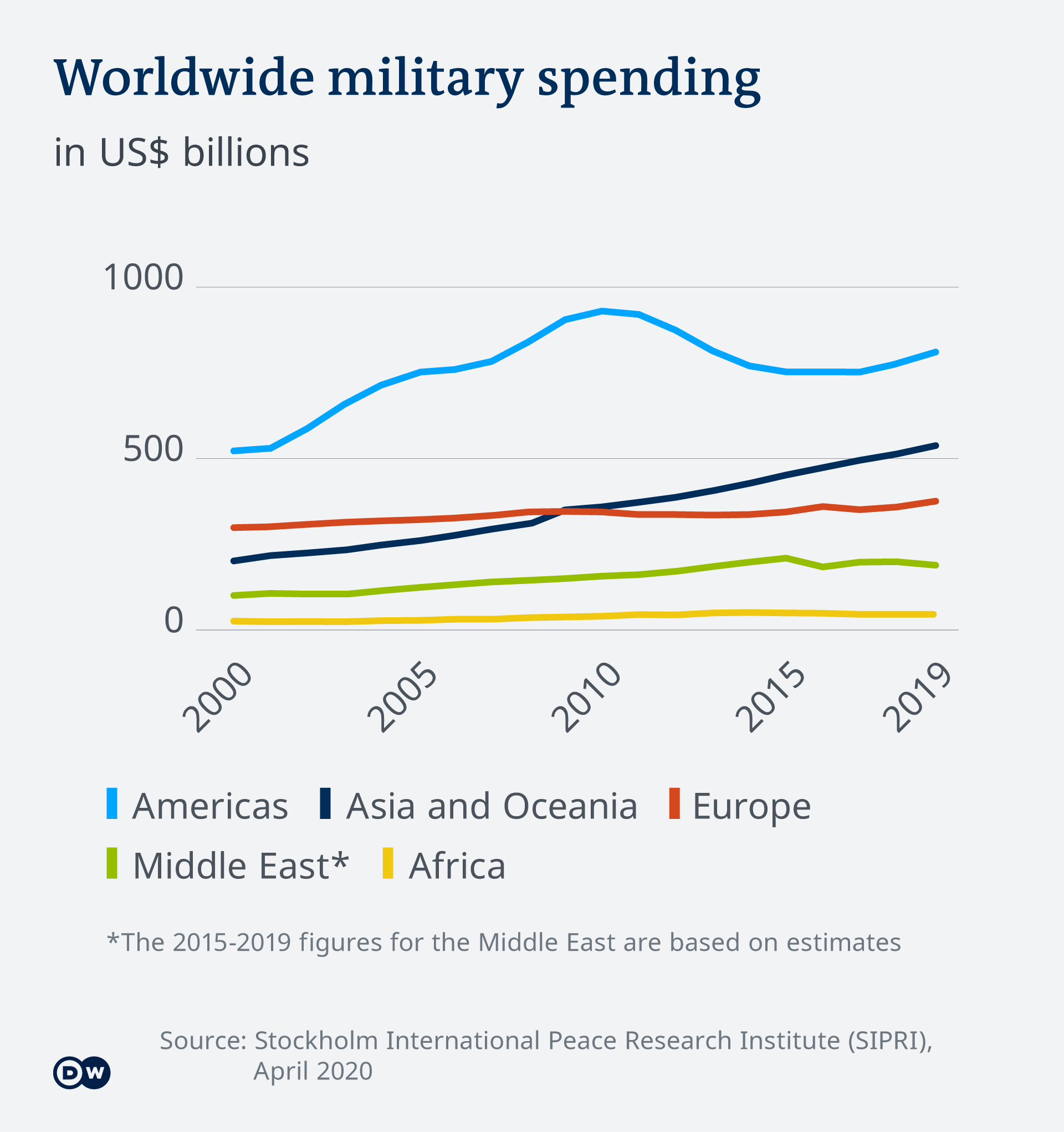
Of the 15 countries in the world with the highest defense budgets, six are NATO members: Canada, France, Germany, Italy, the United Kingdom and the United States. Their combined military expenditure makes up for almost half of the world's total figure. In 2019, the total military expenditure of NATO's 29 member states was some $1.04 trillion, a figure that didn't surprise Mutschler.
"Military expenditure is based on worst-case scenarios," he told DW, explaining that while the public often perceives economic conflict between states to be in the foreground, the threat of military conflict remains very present in the background.
"With regard to the tension between the US and China, we do not know if there will be an armed conflict or not. So the militaries in both countries are preparing for this eventuality, and they're very good when it comes to lobbying for more funds," he said.
China displays its military strength
US still well ahead of China
According to the SIPRI report, in 2019 the US was responsible for 38% of global military expenditure, totaling $732 billion. The increase over its 2018 budget alone amounted to the equivalent of Germany's total expenditure in 2019.
Those funds went to cover some 16,000 extra military personnel, along with the modernization of its conventional weaponry and nuclear arsenal. But experts also see the increase as a response to China, which ranks in second place after the US when it comes to military spending. Beijing's budget contributed 14% of global military expenditure in 2019 and rose by more than 5% to $261 billion.
China has been increasing its military expenditure steadily since 1994, but its budget has jumped by 85% since 2010. However, in terms of percentage of GDP, this has not changed considerably and almost always lies at 1.9%.
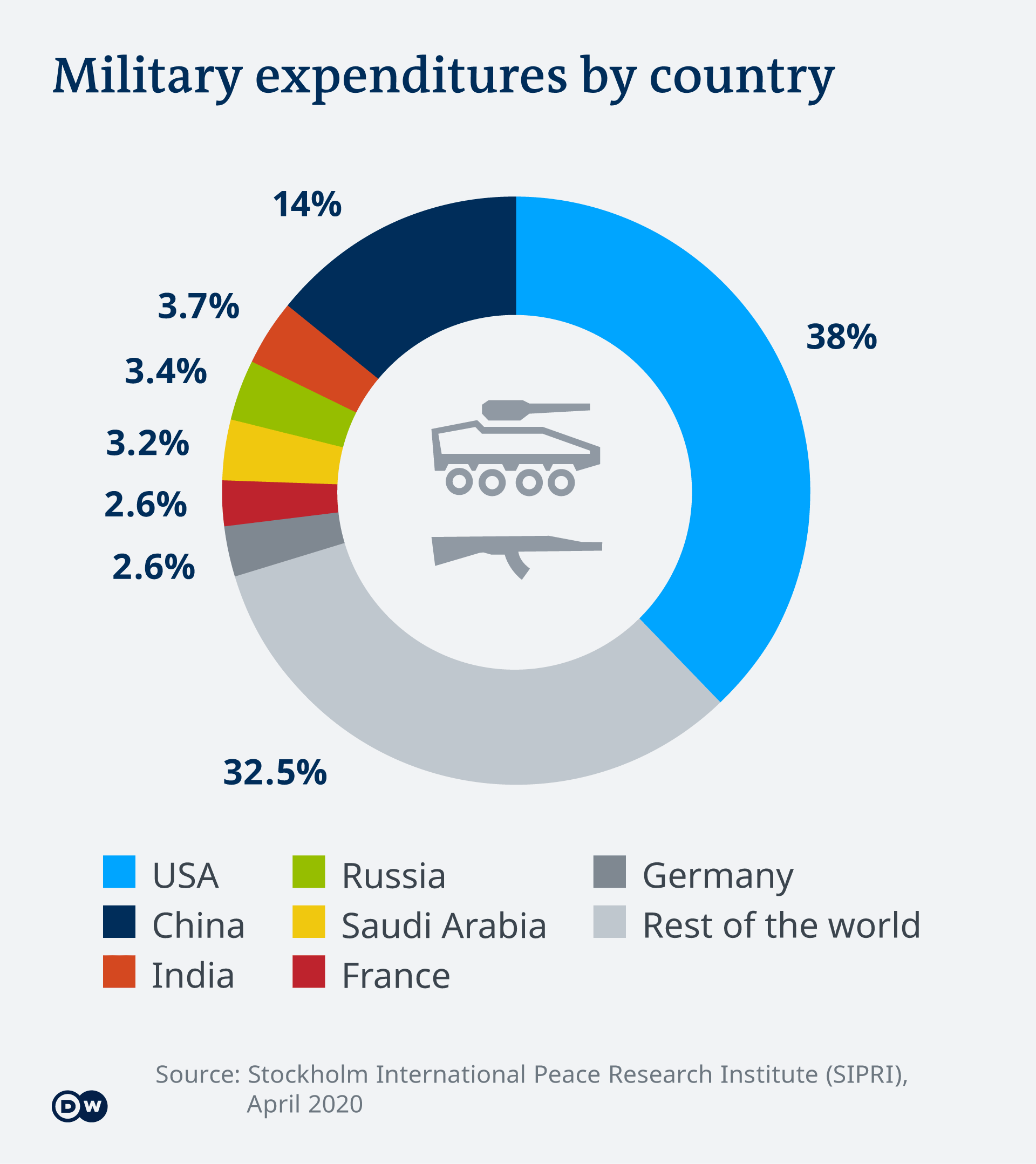
India surpasses Saudi Arabia
On the Asian continent, the military expenditure of China's rival, nuclear power India, is also considerable, rising last year by almost 7% to $71.1 billion.
"The tension with neighboring countries Pakistan and China are the main reasons that the Indian government has increased its expenditure so dramatically," said Siemon Wezeman, a senior researcher with SIPRI.
For its part, Saudi Arabia lies well ahead of other Middle Eastern countries, spending $61.9 billion in 2019 — though this was actually a 16% decrease in comparison with the previous year. The figure was a surprising development, according to the SIPRI report, considering the Saudi kingdom's ongoing military operations in Yemen and increasing tensions with Iran.
German weapons for Saudi Arabia
Emerging economies spend much less
Military expenditure in other countries pales by comparison to the global top spenders. South American states spent "only" $53 billion in 2019, and Brazil alone was responsible for half of that.
Southeast Asian countries totaled around $41 billion, and the entire continent of Africa spent some $42 billion, though there were considerable fluctuations depending on the states. Uganda, for example, increased its budget by 52%, while Burkina Faso decreased its expenditure by 22%.
The authors of the SIPRI report attributed the differences in expenditure to the current geopolitical situation in sub-Saharan Africa, and whether or not states are directly involved in a military conflict.
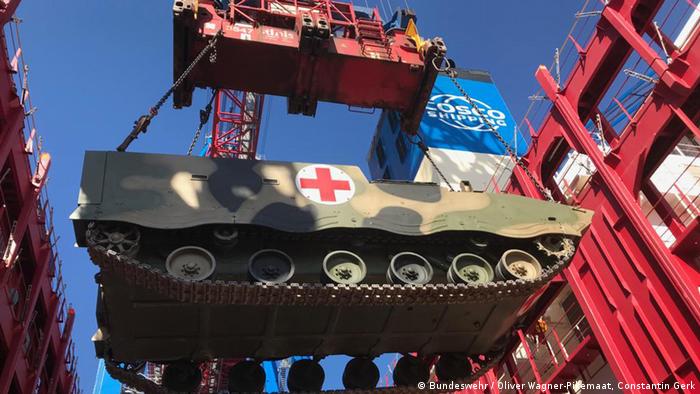
Chinese soldiers train for epidemic in Bavaria
Special delivery
This Chinese armored medical evacuation vehicle arrived by ship at the port in Hamburg, before being shipped to southern Germany and the Bavarian town of Feldkirchen. A total of 92 Chinese and 120 German soldiers are taking part in the Combined Aid 2019 exercise, along with 120 men and women in supporting roles.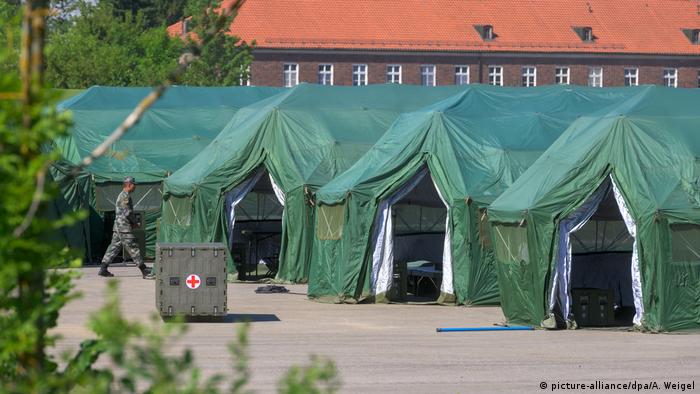
Chinese soldiers train for epidemic in Bavaria
No ordinary exercise
The armored medical evacuation vehicle and other Chinese army supplies were brought here to Feldkirchen, where the exercise is taking place until July 17. It's the first of its kind in Germany in the history of German-Chinese military cooperation. In 2016, 38 Bundeswehr medical orderlies took part in a previous exercise in China.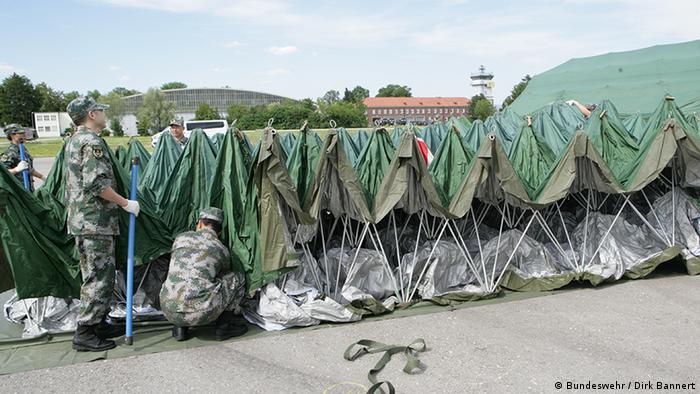
Chinese soldiers train for epidemic in Bavaria
Folding hospital
The exercise is simulating a fictitious UN deployment. The scenario: Cholera has broken out in several refugee camps, and there are many wounded people elsewhere. The Chinese soldiers brought their own mobile hospital along with them for the exercise. It can be pulled out and folded up like an accordion.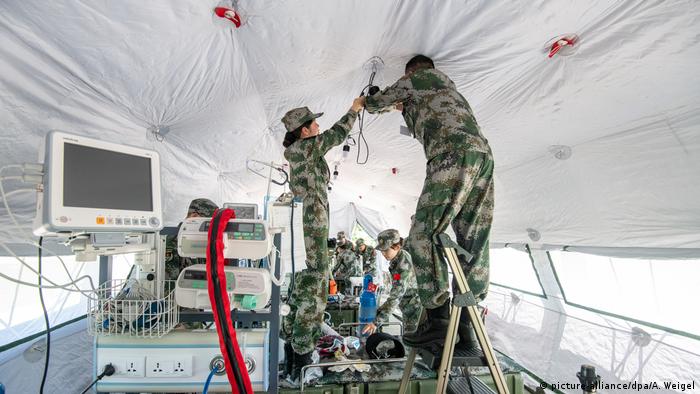
Chinese soldiers train for epidemic in Bavaria
Ready in no time
"It's impressive how fast the mobile equipment from the Chinese People's Liberation Army can be set up," said a Bundeswehr report. "The modern Chinese tents are up and ready within a few minutes, and the medical equipment is put in place just as quickly."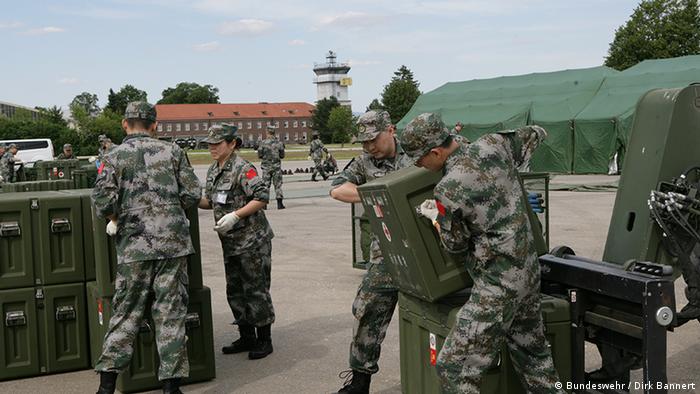
Chinese soldiers train for epidemic in Bavaria
Medical training
In the 2016 joint exercise, training focused on treating and providing for earthquake victims. China has plenty of experience in this area. Following earthquake disasters in 2008, 2010 and 2012, it had to take care of between 40,000 and 50,000 injured people each time. The 2019 exercise only involves medical staff, but it's being seen as a first step toward limited military cooperation.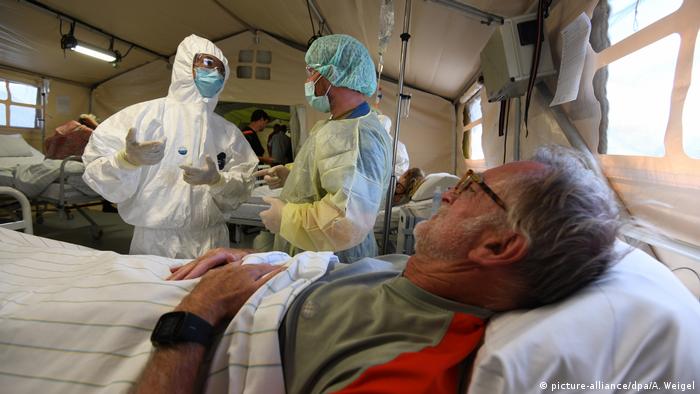
Chinese soldiers train for epidemic in Bavaria
Tricky translation
During the joint exercise, participants either speak English, or use an interpreter. The German army has said the exercise is helping to establish international cooperation, in preparation for a possible cross-border outbreak of disease.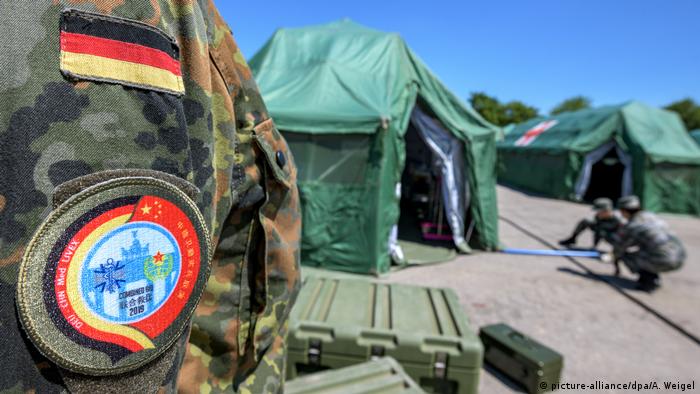
Chinese soldiers train for epidemic in Bavaria
Strong together
The exercise "is also extremely relevant with regard to non-military disease prevention, as there is an international duty to protect the population against epidemics and pandemics," said the Bundeswehr. There's even a joint logo for Combined Aid 2019, incorporating the German and Chinese flags.Author: Marco Müller
Read the whole story
· · · · · · · · · · · · · · · · ·
Promise Me You’ll Shoot Yourself: The Mass Suicide of Ordinary Germans in 1945, by Florian Huber (Little, Brown Spark, 304 pp., $29.00)
What happened to Germany immediately after World War II? This question is often overshadowed by the liberation of the concentration camps and the onset of the Cold War. In Promise Me You’ll Shoot Yourself: The Mass Suicide of Ordinary Germans in 1945, German historian Florian Huber sheds light on a darkly fascinating period. His book, which received its first American printing last month, offers a gripping account of the “suicide epidemic” that swept the Third Reich in its final days. Huber also provides a revealing look into the minds and souls of ordinary Germans forced to confront the reality of Nazism.
Through diaries, memoirs, and public records, Huber follows ordinary Germans through the Reich’s last days, which were, for many, the last days of their lives. We meet the elderly couples who hung themselves together, the fathers who shot their families before taking their own lives, and the mothers who marched to their fate in icy rivers, dragging their children behind them. After detailing these grim scenes, Huber looks back to 1926, tracing the rise of the Nazis and analyzing how ordinary Germans came under their spell. He shows how even those who joined the Nazi Party for reasons of expediency or youthful ignorance were corrupted by the Reich’s twisted morality.
Huber ultimately understates the significance of the German mass suicides. For him, Germans who killed themselves in 1945 did so either to avoid the fate that awaited them at the hands of the Allies—like the citizens fearful of the brutality of Russian soldiers, as was Hitler himself—or to escape the guilt that would overwhelm them once imminent defeat revived their dormant consciences. Whatever the reasons, the sheer number of Germans who chose to take their own lives is remarkable. As Huber notes, the Christian prohibition on suicide still held great power in Germany. In a sermon in March of that year, a Berlin vicar attempted to dissuade his congregants—many of whom had confessed thoughts of suicide—from ending their lives.
Huber notes, however, that “the power of this taboo” faded “against the backdrop of the physical, emotional, and mental horrors of Germany’s downfall.” As the Red Army advanced, “social conventions . . . no longer seemed to apply,” as suicide transformed from a sin to “a last resort before total surrender [and] a consolation to the desperate.”
Attributing the suicides to a change in norms misses a subtle, yet crucial, point. To the extent that social norms changed, they did so as a result of the moral collapse that Nazism wrought in Germany. One influential explanation of this collapse was offered by Hannah Arendt, the German-Jewish political theorist. Huber relies on Arendt’s 1950 report The Aftermath of Nazi Rule to capture the inability or unwillingness of Germans who survived past 1945 to grapple with their country’s actions. But a key to understanding the German suicides may actually lie in Arendt’s controversial 1963 work, Eichmann In Jerusalem: A Report on the Banality of Evil, where she explores “the totality of the moral collapse” ushered in by Nazism. She observes that “just as the law in civilized countries assumes that the voice of conscience tells everybody ‘Thou shalt not kill’ . . . so the law of Hitler’s land demanded that the voice of conscience tell everybody: ‘Thou shalt kill.’”
Mass suicide sprang from a similar inversion of moral imperatives, one that transformed self-harm from a sin into a necessity. In a sense, it was the logical conclusion of the twisted morality that Arendt described: standing face-to-face with the abyss, thousands of Germans followed Nazism’s commandment to kill—one last time. Promise Me You’ll Shoot Yourself offers important historical insight for any theoretical analysis of Nazism. By cataloguing the self-inflicted carnage of 1945, Huber offers another way of understanding the human cost of political evil.
Tim Rice is a writer and editor based in Washington.
Photo by Fred Ramage/Keystone Features/Getty Images
City Journal is a publication of the Manhattan Institute for Policy Research (MI), a leading free-market think tank. Are you interested in supporting the magazine? As a 501(c)(3) nonprofit, donations in support of MI and City Journal are fully tax-deductible as provided by law (EIN #13-2912529).SUPPORT
Read the whole story
· · ·
- COVID-19 Is Causing Blood Clots and Strokes in Some Patients—but Doctors Don't Know Why Health.com
- Why Is COVID-19 Coronavirus Causing Strokes In Young And Middle-Aged People? Forbes
- Doctors report COVID-19 causing strokes in some young, middle-aged adults KARE11.com
- This new coronavirus symptom is the worst and most serious one yet TweakTown
- Healthy Young People Barely Sick With Covid-19 Are Dying From Strokes balleralert.com
- View Full Coverage on Google News
North Korean leader Kim Jong Un hasn't been seen in public in over two weeks and rumors are swirling about his health. Jung H. Pak, a former CIA officer and author of "Becoming Kim Jong Un: A Former CIA Officer's Insights into North Korea's Enigmatic Young Dictator," joins CBSN's Tanya Rivero with analysis.
Health officials have tested more than 1,000 Tyson Fresh Meats plant workers for COVID-19 in Wallula, Washington, near Pasco. As of Friday afternoon, 111 have tested positive in the plant that slaughters and processes beef products.
Workers said they were concerned that they were still cutting meat a day after the company announced that it was taking a “pause.”
After their shifts, workers lined up in the plant’s cafeteria to get tested for COVID-19. Health officials say they’re using phone translation services because about a dozen languages are spoken inside the plant.
Walla Walla County health director Meghan DeBolt says workers work close together inside.
“It’s just pretty much the perfect breeding ground for COVID-19 and a complete public health nightmare,” DeBolt said.
DeBolt says now workers will isolate at home while they’re waiting for test results.
The plant has been the site of a growing number of cases over the past week, with Tyson saying it would implement more safety measures to address further inspections and avoid shutting down.
Earlier this week, the central Washington fruit giant Stemilt said at least 36 workers had tested positive for COVID-19 around its field operation in the Wenatchee area.9(MDAzMTY3NDM2MDEyMzYyODg4ODVhMjM5Ng001))
9(MDAzMTY3NDM2MDEyMzYyODg4ODVhMjM5Ng001))
Next Page of Stories
Loading...
Page 4
27th April 2020 · 0 Comments
(BlackmansStreet.Today) — Blacks comprised 30 percent of COVID-19 cases in the U.S. as of Saturday, the Centers for Disease Control and Prevention recently reported with little fanfare although Black-elected officials had been pushing for release of national demographic data concerning coronavirus infections and deaths among African Americans.
The data comes with a big explanation. The numbers we hear and see on TV, read on the websites of the Johns Hopkins Center and the World Health Organization are markedly different from what the CDC has published.
The CDC, reported on Saturday, April 18, the number of COVID-19 cases by race, explaining the figures are updated daily. The numbers include data from all 50 states, the District of Columbia, Guam, Puerto Rico, Northern Mariana Islands and the U.S. Virgin Islands.
Numbers reported on Saturday and Sunday are preliminary and not yet confirmed by the state and territorial health departments, the CDC said.
The CDC does not know the exact number of COVID-19 illnesses, hospitalizations, and deaths for a variety of reasons.
COVID-19 can cause mild illness, symptoms might not appear immediately, there are delays in reporting and testing, not everyone who is infected get tested or seeks medical care, and there may be differences in how states and territories confirm numbers in their jurisdictions.
Of the 497,161 total COVID-19 cases as of April 18, Blacks accounted for 36,498, compared with whites who accounted for 77,235 cases. Asians accounted for 5,307 cases and Hispanics accounted for 20,244 cases. The data also includes Native Hawaiian or Pacific Islander or 383 cases, Native Americans or Alaska Natives 765 cases
By age group, Blacks under 18 accounted for 437 cases (28.5 percent), Blacks 18-44 accounted for 11,018 (31 percent), Blacks 45 to 64 accounted for 14,218 cases (33 percent), Blacks 65 to 74 accounted for 5,293 cases (34 percent) and Blacks 75 and older accounted for 4,601 cases (22.3 percent) and there 931 cases (20 percent) involving people whose age group is not known. The total figure comes to 36, 498 or 30 percent.
This article originally published in the April 27, 2020 print edition of The Louisiana Weekly newspaper.
Read the whole story
· ·
- A study of 5,700 coronavirus patients who were treated in Northwell Health hospitals in the New York area reveals that only some 30% of patients had a fever when they were admitted.
- Fever is widely believed to be the most common symptom in COVID-19 cases, but the study indicates that not all patients have experience high temperatures.
- The study offered additional statistics about the use of mechanical ventilation, comorbidities, and the outcome of patients with hypertension.
- Visit BGR’s homepage for more stories.
If you experience a fever, cough, shortness of breath, and fatigue, you might have COVID-19. But the novel coronavirus isn’t the only explanation for your symptoms. You could also have the flu, a common cold, or some other medical condition. But COVID-19 will be the first thing that pops into your mind, and that’s the right way to go about it. Suspecting a COVID-19 infection can prevent you from spreading whatever disease you have by isolating yourself from others. Keeping track of the evolution of your undiagnosed illness is key while you’re showing symptoms, and your progress might help your doctor determine whether or not to advise hospital care.
Click to find out more about a new promotion
Don't miss this content from our sponsor
A new study says that not all of the common COVID-19 symptoms might actually be as prevalent as we thought. Only some 30% of more than 5,700 patients in the New York area experienced fever before being admitted to the hospital, says a brand new study. The conclusion might be surprising, but it does reinforce another few ideas. First of all, there are plenty of asymptomatic COVID-19 carriers out in the wild, as well as plenty of people who experience a mild version of the disease and never have to go to a hospital. Secondly, social distancing measures have to stay in place as testing increases to reduce transmission risk.
[bgr-dont-miss url=”” title=”” label=”” gradient=”” use_amazon_link=”” ignore_global=””
The Northwell Health system network published a study in the Journal of the American Medical Association that looked at the characteristics, comorbidities, and outcomes of 5,700 patients who were hospitalized with COVID-19 in the New York City Area including New York City, Long Island, and Westchester County.
The study included all the patients hospitalized between March 1st and April 4th in 12 hospitals or a total of 5,700 patients with a median age of 63 years old. At triage, 30.7% of patients were febrile (fever higher than 38C or 100.4F). 17.3% had a respiratory rate higher than 24 breaths/min and were receiving 27.8% oxygen. A respiratory rate of between 12 and 20 breaths/min is considered normal in adults.
It’s unclear if any of the patients treated their fever at home before admission. The study only makes a note of hypertension treatment, as some of the drugs used to manage the cardiac condition may affect or be affected by the virus.
Different research showed that fever might last anywhere from eight to 11 days in COVID-19 patients.
The fever statistics certainly stand out, but the study did reveal other interesting findings:
- The most common comorbidities include hypertension, obesity, and diabetes.
- The first COVID-19 test was positive for 96.8% of the patients, and false-negative for the rest
- 2.1% of the patients also had other respiratory infections.
- Of the 2,634 patients who were discharged or died, 14.2% were treated in the ICU, 12.2% were put on ventilators, 3.2% received kidney replacement therapy, and 21% died. The rest were still hospitalized at the end of this study.
- Of the 1,151 patients who required medical ventilation as of April 4th, 38 were discharged alive, 282 died, and 831 remained in the hospital.
- The mortality rate was 0% for patients younger than 20, but the rate then increased more for men than women, for every 10-year age interval that followed.
- The mortality rate for 18-to-65 patients on ventilators was at 76.4% compared to 97.2% for older-than-65 patients.
- The mortality rate for 18-to-65 who did not receive ventilation was at 19.8% compared to 26.6% for older-than-65 patients.
- Of the patients who died, those with diabetes were more likely to have received ventilation or ICU care.
- More patients who had diabetes were likely to develop kidney injury than the others.
- Of the patients who died, those with hypertension were less likely to have received ventilation or ICU care compared with people without hypertension.
The last one is certainly an interesting conclusion, one that deserves more scrutiny. The study also focuses on hypertensive patients, as it looks at Angiotensin-Converting Enzyme Inhibitor (ACEi) and Angiotensin II Receptor Blocker (ARB) therapies in hypertension on COVID-19 patients. The virus binds to ACE2 receptors, and that’s why these drugs may have beneficial or adverse effects:
ACEi and ARB medications can significantly increase mRNA expression of cardiac angiotensin-converting enzyme 2 (ACE2), leading to speculation about the possible adverse, protective, or biphasic effects of treatment with these medications. This is an important concern because these medications are the most prevalent antihypertensive medications among all drug classes. However, this case series design cannot address the complexity of this question, and the results are unadjusted for known confounders, including age, sex, race, ethnicity, socioeconomic status indicators, and comorbidities such as diabetes, chronic kidney disease, and heart failure.
2,411 patients of the ones who died or were discharged were on a hypertension drug, including 189 on ACEi and 267 on ARB. 91 patients continued taking the ACEi treatment in hospitals, and 136 continued their ARB treatment. Of the patients who were not prescribed either type of drug, 49 started treatment with an ACEi, and 58 got ARB drugs. Mortality rates were at 26.7%, 32.7%, and 30.6% for patients not taking any ACEi or ARB drugs, taking ACEi, and taking ARB, respectively.
It’s unclear why some patients were taken off or put on ACEi or ARB, and whether those decisions are related to the COVID-19 evolution. Also, the study doesn’t mention whether any of the patients received any trial therapy that may have had side-effects on the heart. The use of hydroxychloroquine in certain COVID-19 therapies resulted in significant heart-related issues.
“This study represents the first large case series of sequentially hospitalized patients with confirmed COVID-19 in the US,” the authors explain. As interesting as the conclusions might be, the researchers warn that certain limitations may affect the final numbers. for starters, 3,066 patients were still hospitalized when the research was published, and their outcome wasn’t factored in any of the numbers. Mortality rates could be significantly altered once all of the patient data is available.
Furthermore, the data was collected from electronic health records, which means it might lack key details that could be obtained after a manual review of medical records. The researchers also wan there may be unadjusted confounders affecting certain statistics.
Image Source: CHINE NOUVELLE/SIPA/Shutterstock

Chris Smith started writing about gadgets as a hobby, and before he knew it he was sharing his views on tech stuff with readers around the world. Whenever he's not writing about gadgets he miserably fails to stay away from them, although he desperately tries. But that's not necessarily a bad thing.
Read the whole story
· · · · ·

____________________________________________________________
#FDA,
Are you in charge of the food safety matters? What is going on? Are you investigating this?
What is your understanding of this dangerous situation?
#CIA #FBI #ODNI #Trump #CDC #Covid19 #Coronavirus #Meatplants #Covid19InMeatPlantWorkers #CoronavirusInPetFood #IsMeatSafe?
Michael Novakhov - Posts on Twitter - 250 | Page
_____________________________________
» mikenov on Twitter: Is meat contaminated with Coronavirus? - Google Search google.com/search?q=Is+me…
27/04/20 16:39 from Michael Novakhov on Twitter from Michael_Novakhov (1 sites)
Is meat contaminated with Coronavirus? - Google Search google.com/search?q=Is+me… Posted by mikenov on Monday, April 27th, 2020 7:39pm mikenov on Twitter
27/04/20 16:39 from Michael Novakhov on Twitter from Michael_Novakhov (1 sites)
Is meat contaminated with Coronavirus? - Google Search google.com/search?q=Is+me… Posted by mikenov on Monday, April 27th, 2020 7:39pm mikenov on Twitter
» mikenov on Twitter: As they rushed to maintain U.S. meat supply, big processors saw plants become covid-19 hot spots, worker illnesses spike washingtonpost.com/business/2020/…
27/04/20 16:33 from Michael Novakhov on Twitter from Michael_Novakhov (1 sites)
As they rushed to maintain U.S. meat supply, big processors saw plants become covid-19 hot spots, worker illnesses spike washingtonpost.com/business/2020/… Posted by mikenov on Monday, April 27th, 2020 7:33pm mikenov on Twitter
27/04/20 16:33 from Michael Novakhov on Twitter from Michael_Novakhov (1 sites)
As they rushed to maintain U.S. meat supply, big processors saw plants become covid-19 hot spots, worker illnesses spike washingtonpost.com/business/2020/… Posted by mikenov on Monday, April 27th, 2020 7:33pm mikenov on Twitter
» mikenov on Twitter: Is pet food infected with Coronavirus? - Google Search google.com/search?q=Is+pe…
27/04/20 16:22 from Michael Novakhov on Twitter from Michael_Novakhov (1 sites)
Is pet food infected with Coronavirus? - Google Search google.com/search?q=Is+pe… Posted by mikenov on Monday, April 27th, 2020 7:22pm mikenov on Twitter
27/04/20 16:22 from Michael Novakhov on Twitter from Michael_Novakhov (1 sites)
Is pet food infected with Coronavirus? - Google Search google.com/search?q=Is+pe… Posted by mikenov on Monday, April 27th, 2020 7:22pm mikenov on Twitter
» mikenov on Twitter: Pet Foods Contain Animal Parts That Don’t Appear on Their Labels | Time time.com/3765180/pet-fo…
27/04/20 16:19 from Michael Novakhov on Twitter from Michael_Novakhov (1 sites)
Pet Foods Contain Animal Parts That Don’t Appear on Their Labels | Time time.com/3765180/pet-fo… Posted by mikenov on Monday, April 27th, 2020 7:19pm mikenov on Twitter
27/04/20 16:19 from Michael Novakhov on Twitter from Michael_Novakhov (1 sites)
Pet Foods Contain Animal Parts That Don’t Appear on Their Labels | Time time.com/3765180/pet-fo… Posted by mikenov on Monday, April 27th, 2020 7:19pm mikenov on Twitter
» mikenov on Twitter: intestines of pigs sick with coronavirus were fed to piglets - Google Search google.com/search?q=intes…
27/04/20 16:16 from Michael Novakhov on Twitter from Michael_Novakhov (1 sites)
intestines of pigs sick with coronavirus were fed to piglets - Google Search google.com/search?q=intes… Posted by mikenov on Monday, April 27th, 2020 7:16pm mikenov on Twitter
27/04/20 16:16 from Michael Novakhov on Twitter from Michael_Novakhov (1 sites)
intestines of pigs sick with coronavirus were fed to piglets - Google Search google.com/search?q=intes… Posted by mikenov on Monday, April 27th, 2020 7:16pm mikenov on Twitter
» mikenov on Twitter: porcine coronavirus - Google Search google.com/search?q=porci…
27/04/20 16:14 from Michael Novakhov on Twitter from Michael_Novakhov (1 sites)
porcine coronavirus - Google Search google.com/search?q=porci… Posted by mikenov on Monday, April 27th, 2020 7:14pm mikenov on Twitter
27/04/20 16:14 from Michael Novakhov on Twitter from Michael_Novakhov (1 sites)
porcine coronavirus - Google Search google.com/search?q=porci… Posted by mikenov on Monday, April 27th, 2020 7:14pm mikenov on Twitter
» mikenov on Twitter: Meat processing plants across the US are closing due to the pandemic. Will consumers feel the impact? - CNN cnn.com/2020/04/26/bus…
27/04/20 16:08 from Michael Novakhov on Twitter from Michael_Novakhov (1 sites)
Meat processing plants across the US are closing due to the pandemic. Will consumers feel the impact? - CNN cnn.com/2020/04/26/bus… Posted by mikenov on Monday, April 27th, 2020 7:08pm mikenov on Twitter
27/04/20 16:08 from Michael Novakhov on Twitter from Michael_Novakhov (1 sites)
Meat processing plants across the US are closing due to the pandemic. Will consumers feel the impact? - CNN cnn.com/2020/04/26/bus… Posted by mikenov on Monday, April 27th, 2020 7:08pm mikenov on Twitter
» mikenov on Twitter: 13 U.S. meat industry workers have died of COVID-19, union says cbsnews.com/news/coronavir… via @cbsmoneywatch
27/04/20 16:00 from Michael Novakhov on Twitter from Michael_Novakhov (1 sites)
13 U.S. meat industry workers have died of COVID-19, union says cbsnews.com/news/coronavir… via @cbsmoneywatch Posted by mikenov on Monday, April 27th, 2020 7:00pm mikenov on Twitter
27/04/20 16:00 from Michael Novakhov on Twitter from Michael_Novakhov (1 sites)
13 U.S. meat industry workers have died of COVID-19, union says cbsnews.com/news/coronavir… via @cbsmoneywatch Posted by mikenov on Monday, April 27th, 2020 7:00pm mikenov on Twitter
» mikenov on Twitter: Mapping Covid-19 in meat and food processing plants thefern.org/2020/04/mappin…
27/04/20 15:57 from Michael Novakhov on Twitter from Michael_Novakhov (1 sites)
Mapping Covid-19 in meat and food processing plants thefern.org/2020/04/mappin… Posted by mikenov on Monday, April 27th, 2020 6:57pm mikenov on Twitter
27/04/20 15:57 from Michael Novakhov on Twitter from Michael_Novakhov (1 sites)
Mapping Covid-19 in meat and food processing plants thefern.org/2020/04/mappin… Posted by mikenov on Monday, April 27th, 2020 6:57pm mikenov on Twitter
» mikenov on Twitter: Meat and poultry plants nationwide have emerged as incubators for coronavirus spread. More than a dozen have been forced to shut down temporarily as the number of cases and deaths tied to those facilities rose texastribune.org/2020/04/
27/04/20 15:55 from Michael Novakhov on Twitter from Michael_Novakhov (1 sites)
Meat and poultry plants nationwide have emerged as incubators for coronavirus spread. More than a dozen have been forced to shut down temporarily as the number of cases and deaths tied to those facilities rose texastribune.org/2020/04/27...
27/04/20 15:55 from Michael Novakhov on Twitter from Michael_Novakhov (1 sites)
Meat and poultry plants nationwide have emerged as incubators for coronavirus spread. More than a dozen have been forced to shut down temporarily as the number of cases and deaths tied to those facilities rose texastribune.org/2020/04/27...
» mikenov on Twitter: Meatpacking workers in Texas Panhandle have little power to avoid the coronavirus texastribune.org/2020/04/27/mea… via @TexasTribune
27/04/20 15:54 from Michael Novakhov on Twitter from Michael_Novakhov (1 sites)
Meatpacking workers in Texas Panhandle have little power to avoid the coronavirus texastribune.org/2020/04/27/mea… via @TexasTribune Posted by mikenov on Monday, April 27th, 2020 6:54pm mikenov on Twitter
27/04/20 15:54 from Michael Novakhov on Twitter from Michael_Novakhov (1 sites)
Meatpacking workers in Texas Panhandle have little power to avoid the coronavirus texastribune.org/2020/04/27/mea… via @TexasTribune Posted by mikenov on Monday, April 27th, 2020 6:54pm mikenov on Twitter
» mikenov on Twitter: Neurological Impact of Coronavirus: Stroke, Confusion & Dizziness; COVID-19 Can Impact Brain in Some Cases fit.thequint.com/coronavirus/ne…
27/04/20 15:50 from Michael Novakhov on Twitter from Michael_Novakhov (1 sites)
Neurological Impact of Coronavirus: Stroke, Confusion & Dizziness; COVID-19 Can Impact Brain in Some Cases fit.thequint.com/coronavirus/ne… Posted by mikenov on Monday, April 27th, 2020 6:50pm mikenov on Twitter
27/04/20 15:50 from Michael Novakhov on Twitter from Michael_Novakhov (1 sites)
Neurological Impact of Coronavirus: Stroke, Confusion & Dizziness; COVID-19 Can Impact Brain in Some Cases fit.thequint.com/coronavirus/ne… Posted by mikenov on Monday, April 27th, 2020 6:50pm mikenov on Twitter
» mikenov on Twitter: Pandemic coverage and information gaps cjr.org/opinion/china-… via @cjr
27/04/20 15:39 from Michael Novakhov on Twitter from Michael_Novakhov (1 sites)
Pandemic coverage and information gaps cjr.org/opinion/china-… via @cjr Posted by mikenov on Monday, April 27th, 2020 6:39pm mikenov on Twitter
27/04/20 15:39 from Michael Novakhov on Twitter from Michael_Novakhov (1 sites)
Pandemic coverage and information gaps cjr.org/opinion/china-… via @cjr Posted by mikenov on Monday, April 27th, 2020 6:39pm mikenov on Twitter
» mikenov on Twitter: The CIA falsely believed it was 'invincible' in China — here's how its spies were reportedly discovered and killed in one of the biggest blows to the agency businessinsider.com/how-china-foun… via @businessinsider
27/04/20 13:03 from Michael Novakhov on Twitter from Michael_Novakhov (1 sites)
The CIA falsely believed it was 'invincible' in China — here's how its spies were reportedly discovered and killed in one of the biggest blows to the agency businessinsider.com/how-china-foun… via @businessinsider Posted by mikenov on Mo...
27/04/20 13:03 from Michael Novakhov on Twitter from Michael_Novakhov (1 sites)
The CIA falsely believed it was 'invincible' in China — here's how its spies were reportedly discovered and killed in one of the biggest blows to the agency businessinsider.com/how-china-foun… via @businessinsider Posted by mikenov on Mo...
» mikenov on Twitter: Ex-CIA officer jailed for 19 years for spying for China | News | DW | 23.11.2019 dw.com/en/ex-cia-offi…
27/04/20 12:11 from Michael Novakhov on Twitter from Michael_Novakhov (1 sites)
Ex-CIA officer jailed for 19 years for spying for China | News | DW | 23.11.2019 dw.com/en/ex-cia-offi… Posted by mikenov on Monday, April 27th, 2020 3:11pm mikenov on Twitter
27/04/20 12:11 from Michael Novakhov on Twitter from Michael_Novakhov (1 sites)
Ex-CIA officer jailed for 19 years for spying for China | News | DW | 23.11.2019 dw.com/en/ex-cia-offi… Posted by mikenov on Monday, April 27th, 2020 3:11pm mikenov on Twitter
Read the whole story
· · · · · · ·
A rash of coronavirus outbreaks at dozens of meatpacking plants across the nation is far more extensive than previously thought, according to an exclusive review of cases by USA TODAY and the Midwest Center for Investigative Reporting.
- Get link
- X
- Other Apps













Comments
Post a Comment